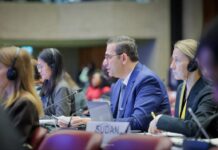
Cameraman Talal Abu Rahma huddled behind a van on Saladin Road in southern Gaza. The street was a shooting gallery and his nostrils filled with the smell of death as blood stained the asphalt and his ears were assailed by the sound of gunfire and the screams and cries of injured and panicked Palestinians. No one knew where the shots were coming from or whom the gunmen were aiming at, thus there was no safe place to run. Then one of the children seeking refuge with the France 2 reporter pointed across the street and screamed, “They are shooting at them.” Talal turned his gaze and his camera to a father and son pinned by Israeli sniper fire looks of terror and anguish on their faces as shot after shot pounded into the pair. They were 12-year-old Muhammad al-Durrah and his father Jamal. The footage of the murder of a child in his father’s helpless arms sent shock waves around the world in September of 2000 yet it has become a familiar sight in today’s media.
The news media bombard us with a stream of reports on global conflicts and disasters. While this constant stream of information can raise awareness, this relentless barrage of extreme imagery and stories can become overwhelming and numbing. This can have a chilling effect, leading to a sense of helplessness and a diminishing capacity for empathy.
Today media coverage of conflicts and atrocities has become an inescapable reality, whether televised, in print, or live and unfiltered via social media and the internet. From the wars in Syria and Gaza to humanitarian crises around the globe – images of suffering and destruction flood our screens with alarming frequency. Yet, amidst this deluge of information, a troubling phenomenon emerges: desensitization.
As viewers become increasingly accustomed to scenes of violence and despair, their emotional responses wane, giving way to a sense of numbness and detachment. In exploring the intricacies of desensitization, L24 delves into the psychological, societal, and moral implications of prolonged exposure to traumatic events, shedding light on the complex interplay between media representation and human empathy.
The Normalization of Atrocity
Prolonged exposure to violence, atrocities, and images of mass destruction and murder leads to desensitization, which psychologists explain as the gradual weakening of an emotional response due to repeated exposure to a stimulus. In the media context, this translates to a numbing of outrage, empathy, sadness, shock, horror, or anger at the suffering depicted in our daily news feeds.
Dr. Talha Abdulrazaq, a security expert and an award-winning researcher at the University of Exeter’s Strategy and Security Institute, told L24 about the concept of “war fatigue”, especially in the West, where public interest and concern wane as conflicts drag on. He points to the Syrian war as a prime example, where years of relentless violence have led to a sense of hopelessness and a decreased willingness to engage with the issue.

Dr. Ahmad Muwaffaq Zaidan, a journalist and political analyst, sheds light on this phenomenon in an interview with L24, noting, “With the continuation of ongoing wars, viewers gradually become bored over time.” Indeed, the relentless cycle of violence perpetuated by conflicts such as those in Syria and Gaza necessitates a recalibration of media strategies to combat audience fatigue.
This emotional numbing can have a negative impact on our ability to connect with the human stories behind the headlines. Dr. Zaidan emphasizes the importance of focusing on “specific cases” and “reminding people of the tragedies and atrocities” in an individualistic way to personalize the narratives of war and disaster. By bringing a human face to the suffering, Zaidan believes that a sense of empathy can be rekindled and viewers compelled to engage with the issue on a deeper level.
The shaping of the public’s perception of global events, notes Dr. Zaidan, is magnified by the growing influence of social media platforms like Twitter and Facebook. These platforms allow for “provocation, mobilization, and rallying,” amplifying public sentiment and influencing traditional media coverage. This is evident, says Zaidan, in the Gaza issue where “The entire world is now connected through social media.” Therefore, he asserts, “Paying attention to these platforms is a crucial factor in influencing public opinion.”

Bias and Engineering Opinion
The media acts as a powerful arbiter of public opinion and plays a pivotal role in shaping perceptions of ongoing crises which can result in heavy costs for the people on the ground. Dr. Philips expands on how the lack of objectivity in media coverage, particularly in the MENA region, where Palestinians and Syrians are often dehumanized and misrepresented – can have devastating effects. “Articles omit the perpetrator, deny the number of deaths, equate ‘both sides’ despite asymmetric power, and dehistoricize the context,” she observes, highlighting the inherent biases that pervade mainstream media narratives.
This manipulation of public sentiment is not lost on governments, which, Dr. Philips claims, often exploit compassion fatigue for their political agendas. “Unfortunately, I believe that many governments benefit from or manipulate people’s compassion fatigue in response to atrocities,” she remarks. This calculated manipulation further perpetuates a cycle of desensitization, as audiences become increasingly cynical and distrustful of media portrayals. According to Philips, Western audiences “are less likely to identify with Arabs and Muslims – people who have otherwise been Othered and radicalized in Western contexts.”

The Need for Fostering Empathy
Despite the challenges, fostering empathy and understanding for those affected by war and disaster remains crucial. L24 reached out to Hassan Hassan, founder of the New Lines Magazine, and an author and journalist specializing in the Middle East, who acknowledges the limitations of traditional media coverage. It is by highlighting the everyday lives of those affected, that bridges of understanding are built to counteract the dehumanizing effects of war imagery, “It’s more effective,” says Hassan, “to read about other people as they live their ordinary lives. This will make us see others as people like us, and makes them even more relatable when they face hardships.” This strategy is one he uses in his own publication, “We try to do this at New Lines Magazine, by providing ordinary and relatable stories and ideas from ordinary people every day throughout the year.”
However, Dr. Abdulrazaq maintains that breaking the cycle of desensitization requires a multi-pronged approach and the need for a “change in discourse and narrative.” Media outlets have a responsibility to move beyond sensationalized coverage and present stories that humanize the victims of conflict. Governments, posits Abdulrazaq, can play a role by framing their responses in a way that appeals to public compassion and highlights the ethical imperatives of intervention. “It takes moral courage for a politician to go against the grain and encourage empathy with those suffering from the destructive effects of war,” he asserts. However, he acknowledges the political risks associated with such a stance, emphasizing the need for systemic change within media and political institutions.









